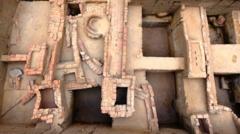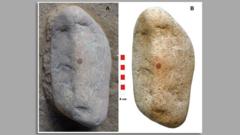Archaeologists have made a startling find beneath a soccer field in Vienna, revealing a mass grave linked to the age of the Roman Empire, dating back nearly 2,000 years. The discovery, made last October during field renovations, has been confirmed by experts from the Vienna Museum, stating it is related to intense military confrontations between Roman forces and Germanic tribes.
The remains of at least 129 individuals display signs of battle injuries, suggesting they were part of a catastrophic military conflict that resulted in a hasty retreat by Roman soldiers. Radiocarbon dating places the grave's remains to approximately A.D. 80 to 234, a time marked by a succession of Roman emperors, such as Domitian and Trajan, who had significant military dealings in this region.
Artifacts found within the grave, including iron daggers, spear points, scale armor, and fragments of a helmet cheek piece, back up the timeline established by the dating. Notably, the presence of shoe nails from Roman military footwear known as caligae supports the identification of the individuals as soldiers.
This discovery is particularly significant, as it is rare to find unburned human remains from this era in central Europe, where cremation was mostly practiced until the third century A.D. Lead anthropologist Michaela Binder remarked on the uniqueness of this find, highlighting the opportunity to explore the life stories of first-century individuals, beyond their military roles. This excavation provides invaluable insight into a lesser-known chapter of Roman history.
The remains of at least 129 individuals display signs of battle injuries, suggesting they were part of a catastrophic military conflict that resulted in a hasty retreat by Roman soldiers. Radiocarbon dating places the grave's remains to approximately A.D. 80 to 234, a time marked by a succession of Roman emperors, such as Domitian and Trajan, who had significant military dealings in this region.
Artifacts found within the grave, including iron daggers, spear points, scale armor, and fragments of a helmet cheek piece, back up the timeline established by the dating. Notably, the presence of shoe nails from Roman military footwear known as caligae supports the identification of the individuals as soldiers.
This discovery is particularly significant, as it is rare to find unburned human remains from this era in central Europe, where cremation was mostly practiced until the third century A.D. Lead anthropologist Michaela Binder remarked on the uniqueness of this find, highlighting the opportunity to explore the life stories of first-century individuals, beyond their military roles. This excavation provides invaluable insight into a lesser-known chapter of Roman history.




















